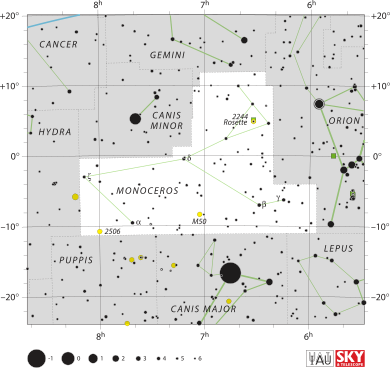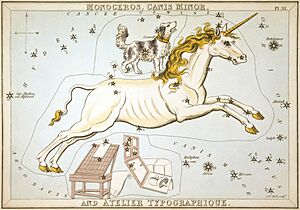Monoceros facts for kids
| Constellation | |

List of stars in Monoceros
|
|
| Abbreviation | Mon |
|---|---|
| Genitive | Monocerotis |
| Pronunciation | genitive |
| Symbolism | the Unicorn |
| Right ascension | 7.15h |
| Declination | −5.74° |
| Quadrant | NQ2 |
| Area | 482 sq. deg. (35th) |
| Main stars | 4 |
| Bayer/Flamsteed stars |
32 |
| Stars brighter than 3.00m | 0 |
| Stars within 10.00 pc (32.62 ly) | 4 |
| Brightest star | β Mon (3.76m) |
| Messier objects | 1 |
| Meteor showers |
|
| Bordering constellations |
|
| Visible at latitudes between +75° and −90°. Best visible at 21:00 (9 p.m.) during the month of February. |
|
The Monoceros constellation is often called "The Unicorn." Its name comes from the Greek word for unicorn. It's a faint group of stars in the night sky, located along the celestial equator. This means it can be seen from almost anywhere on Earth! A mapmaker named Petrus Plancius first officially described it in the 1600s. Monoceros is surrounded by other famous constellations like Orion, Gemini, Canis Major, and Hydra. You can also find Canis Minor, Lepus, and Puppis nearby.
Exploring the Unicorn Constellation
Monoceros is full of amazing objects, from distant stars to colorful nebulae. Let's explore some of its most exciting features!
Amazing Stars in Monoceros
Monoceros has many interesting stars, even though most are quite faint. You might need a telescope to see them clearly!
Brightness of Stars
Stars like Alpha Monocerotis and Gamma Monocerotis are some of the brightest in the constellation. Their brightness is measured using something called "visual magnitude." The lower the number, the brighter the star appears.
Multiple Star Systems
- Beta Monocerotis is a special star system with three stars orbiting each other! They form a perfect triangle in the sky. In 1781, astronomer William Herschel called it "one of the most beautiful sights in the heavens."
- Epsilon Monocerotis is another cool system, but it has two stars instead of three. These two stars orbit each other closely.
- Plaskett's Star is a huge binary system. It contains two massive stars that together weigh almost 100 times more than our Sun!
Stars That Change
- S Monocerotis is a bluish-white variable star that changes its brightness slightly over time. It sits right in the middle of a beautiful star cluster called NGC 2264.
- V838 Monocerotis is a red supergiant star that had a huge burst of light in 2002. Its brightness increased by 10,000 times in just one day! After this event, the Hubble Space Telescope captured amazing images of a "light echo." This is when light from the burst bounced off dust around the star, making it glow.
A Nearby Black Hole
Did you know Monoceros is home to one of the closest black holes to our Solar System? It's part of a two-star system called A0620-00. This black hole is about 3,300 light-years away and is estimated to be 6.6 times the mass of our Sun.
Scholz's Star's Close Encounter
About 70,000 years ago, a star system called Scholz's Star passed very close to our Solar System. This system includes a red dwarf star and a brown dwarf. It traveled within the Oort cloud, which is a distant region of icy objects surrounding our Sun.
Discovering Planets Beyond Our Solar System
Monoceros is also home to some exciting exoplanets, which are planets outside our Solar System!
- CoRoT-7b and CoRoT-7c are two "super-Earth" planets found in the same star system within Monoceros.
- The CoRoT satellite discovered CoRoT-7b. It was once the smallest exoplanet whose size had been measured. It is about 1.58 times wider than Earth.
- Scientists found CoRoT-7c using powerful telescopes on the ground. Both of these planets were discovered in 2009.
Amazing Nebulae and Star Clusters
Monoceros is a treasure chest of amazing deep-sky objects! Because it lies in the direction of our galaxy's main disk, lots of interstellar dust hides distant galaxies. But this dust also creates beautiful nebulae and star clusters.
- Messier 50 is a bright open cluster of stars. It looks like a sparkling diamond scattered across the sky.
- The Rosette Nebula (also known as NGC 2237, 2238, 2239, and 2246) is a huge cloud of gas and dust where new stars are born. It looks like a giant rose in space! This diffuse nebula is about 4,900 light-years away and is over 100 light-years wide. It was discovered in the 1880s by astronomers Lewis Swift and Edward Emerson Barnard.
- The Christmas Tree Cluster (NGC 2264) is another open cluster. It's named this way because its stars form the shape of a Christmas tree! It's about 2,400 light-years from Earth. The variable star S Monocerotis is like the trunk of the tree, and another variable star, V429 Monocerotis, is at the very top.
- The Cone Nebula (also part of NGC 2264) is a very dim cloud of gas and dust. It has a dark, cone-shaped structure that is hard to see with a telescope but looks amazing in photographs. Inside, there are Herbig–Haro objects, which are small, glowing patches of gas around very young stars.
- The Hubble's Variable Nebula (NGC 2261) is a fascinating nebula named after the famous astronomer Edwin Hubble. It's about 2,500 light-years away. A young, changing star called R Monocerotis lights up this nebula. The way this star interacts with the surrounding gas and dust makes the nebula change its appearance over time.
- IC 447 is a reflection nebula, which means it shines by reflecting light from nearby stars.
The Story Behind the Unicorn Constellation

Unlike many ancient constellations, Monoceros is a newer addition to our star maps. The famous astronomer Ptolemy didn't include it in his ancient list of constellations.
How Monoceros Was Discovered
- The first clear record of Monoceros appeared on a celestial globe made by the mapmaker Petrus Plancius around 1612 or 1613.
- Later, in 1624, German astronomer Jakob Bartsch included it on his star chart, calling it "Unicornu."
Older Mentions of the Unicorn
Some historians think that people might have seen a "unicorn" constellation even earlier. There are old writings that mention a "second horse" in this area of the sky. However, these older descriptions don't perfectly match the Monoceros we know today. Some even say that Joseph Scaliger found Monoceros on an ancient Persian star map.
Monoceros in Chinese Astronomy
Long before Western astronomers defined Monoceros, people in China had their own ways of mapping the stars. Several Chinese star groups, or "asterisms," were located in the same part of the sky where Monoceros is today. These included Sze Fūh (the Four Great Canals), Kwan Kew, and Wae Choo (the Outer Kitchen).
See also
 In Spanish: Monoceros para niños
In Spanish: Monoceros para niños


